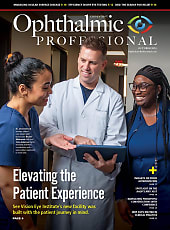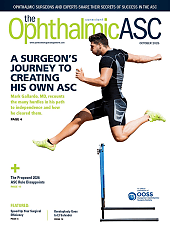During the annual symposium of the Outpatient Ophthalmic Surgery Society (OOSS), a panel of retinal specialists made the case that retina procedures—once seen as too complex or costly for ambulatory surgery centers (ASCs)—are now both clinically appropriate and operationally sustainable. The key, they said, is pairing efficiency with innovation to improve patient care while keeping centers financially healthy.
The discussion, held October 18 during the American Academy of Ophthalmology (AAO) meeting in Orlando, Florida, was moderated by Albert Castillo, MBA, the CEO of San Antonio Eye Center and OOSS’s director of member services. It featured retinal surgeons Ashkan Abbey, MD, of Texas Retina Associates in Dallas, and Vishak John, MD, of Vistar Eye Center in Roanoke, Virginia. Both described how modern techniques and new therapies have made it possible for retina surgeons to deliver high-quality care in the outpatient setting—benefiting patients, surgeons, and the centers that host them.

Figure 1. Ashkan Abbey, MD, (center) speaks during the Innovation in Retina in the ASC program, part of OOSS’s 2025 symposium in Orlando, Florida. Joining him on stage were Vishak John, MD, (left) and moderator Albert Castillo, MBA.
“With the right retina surgeons, you can make retina surgery profitable in your surgery center,” explained Dr. Abbey. “It does require efficiency, but you can provide excellent care and meaningful financial value at the same time.”
He said that many retina surgeries can now be performed under local anesthesia, including vitrectomy and scleral buckle procedures. This avoids the risks and recovery time associated with general anesthesia, benefiting patients while allowing surgeons to move efficiently from one case to the next. “I block two patients ahead of time,” Dr. Abbey said. “As one is being wheeled back, I’m blocking the next. There’s no downtime.” This approach enables him to perform more cases in the ASC during a day, he explained.
Among those cases are short, focused procedures such as vitrectomy for symptomatic vitreous opacities. These surgeries often are short and can significantly improve visual quality and satisfaction for patients, particularly those who have already invested in premium intraocular lenses. “These are the kinds of patients that I think we’ll be seeing more of as time goes on,” noted Dr. Abbey. “If you [as a cataract surgeon] have a good relationship with a retina specialist who's willing to take on those cases, you can definitely have a good partnership.”
Dr. John agreed that efficient workflow is central to successful retina programs in ASCs, noting that early attempts to integrate retina into ASCs sometimes failed because centers tried to fit retina cases into existing cataract surgery schedules. His group found success by rethinking staffing patterns and aligning case types. “When we paired retina with plastic surgery instead of cataracts, our staffing needs and our costs came down,” he said.
The panelists also discussed how new technologies and therapies are creating opportunities for ASCs to expand the scope of retinal care while maintaining financial viability. Dr. Abbey mentioned Encelto (Neurotech Pharmaceuticals), a surgically implanted device approved by the FDA earlier this year to treat macular telangiectasia. Although the price is high, because Encelto has pass-through status the center can be reimbursed for the implant as well as the facility fee. “There are some advantages for a surgery center to offer this as a buy-and-bill product,” said Dr. Abbey. “You get about 3% [margin in reimbursement]. If that is not something you’re interested in, but a surgeon in your center still wants to do it, there is a possibility of using a specialty pharmacy to purchase it. That takes all the financial liability off the ASC.”
Another product with pass-through status is Triesence (Harrow), an FDA-approved intraocular triamcinolone suspension that was recently brought back to market after being unavailable for several years. “We’ve been using off-label kenalog for years to stain the vitreous, but now Triesence gives us a product specifically indicated for use inside the eye, with reimbursement that makes sense for the ASC.”
Advances in gene therapy are likely to increase the number of retina cases that can safely and efficiently be performed in the ASC, added Dr. John. “We have multiple clinical trials for subretinal gene therapy for AMD and diabetic disease,” he said. “In the next few years, we may have FDA approval for some of these medicines. Having efficient retinal surgeons in your practice, and an efficient process for retinal surgery in your ASC, will bring a whole new group of patients to the surgery center.”
Both surgeons stressed that the most successful surgery centers are ones in which retina specialists are active participants in the ASC’s operations and governance. “Retina surgeons who are owners in a surgery center are more likely to help the cataract surgeons make money in the ASC,” said Dr. John. “What I hear a lot from my colleagues who are retina surgeons is that the cataract surgeons don't want them around. If they don’t have ownership, they won’t care about saving money.” RP








